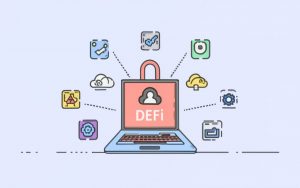Securing Decentralized Finance (DeFi)Cryptocurrency Investments in 2024

The Advent of Decentralized Finance
By eliminating centralized intermediaries through autonomous smart contract protocols, DeFi promises greater asset accessibility and composability. However, the explosive growth of DeFi, with over $100B now locked in protocols, necessitates examining the emerging cyber risk landscape.
DeFi’s Attack Surfaces
The complexity of DeFi introduces new attack vectors including flash loan price manipulation attacks, front-running bots exploiting transaction ordering vulnerabilities, and phishing sites impersonating popular yield aggregators. Developers must also safeguard the keys to admin privileges and treasury funds. As assets flow between chains via bridges, these become prime targets.
Smart Contract Exposures
The DAO hack of 2016 revealed smart contract risks surrounding faulty code and logic errors. Inappropriate permissions granting arbitrary asset transfers or unauthorized minting must stay secured. Reliance on potentially manipulable external data feeds like those supplying price oracles poses dangers. Ensuring smart contract integrity is paramount.
Protecting Investor Wallets
Assets only remain as secure as the wallets safeguarding them. Investors must protect private keys by avoiding phishing attempts, shunning contact requests, installing reputable antivirus software, avoiding infringement of IP rights, and installing hardware wallets for cold storage. Carelessness threatens entire holdings hence users must remain vigilant.
Password Hygiene
Despite their inconvenience, strong passwords limit brute forcing. Length matters more than complexity. Random word stringing with special characters and numbers boosts entropy. Using a password manager enables unique, complex credentials for each protocol while storing them securely. However, securely committing high-value passwords solely to memory may prove wisest.
The Need for Smart Contract Audits
Given the financial assets now locked within DeFi protocols on public chains, the need for rigorous smart contract auditing prior to launch is apparent to prevent costly exploits as repositories grow more complex. Both manual code reviews and formal verification should audit logic. Bug bounties then stress test for flaws. Audits take time but boost security.
Utilizing Multi-Factor Authentication
Activating multi-factor authentication introduces critical secondary account access verification even if passwords or phishing links are compromised. Authentication apps providing one-time codes or hardware security keys executing FIDO login handshakes both strengthen account security. Allowing whitelisted devices avoids constant input.
Monitoring Wallet Activity
Keeping close tabs on linked wallet activity ensures quick detection of any unauthorized transfers indicating a breach. Balance threshold SMS or email alerts also notify users. Watching for unfamiliar tokens can reveal dusting attacks or scam airdrops attempting to steal funds later. Enabling transaction signing confirmation messages hinders crime.
Vetting DeFi Protocols
Investors should scrutinize DeFi protocols before supplying liquidity or acquiring governance tokens based on auditing thoroughness, treasury management transparency, key holder identities, multi-sig protections, bridge integrations, price oracle resilience, white hat bounties, and historical incident response efficacy revealed through research or transparency reports.
Strategic Asset Allocation
Investors achieve optimal risk-adjusted DeFi portfolio returns through allocating assets across stablecoins, majors like ETH, alt L1s, mid and low cap DeFi blue chips, NFT index tokens, liquid staking derivatives, and speculative farm tokens according to personal risk tolerance. Concentration caps prevent overexposure.
Using DeFi Insurance
Protocol coverage through Nexus Mutual and similar DeFi insurers allows coverage for exploits or administration failures in return for premiums, converting unpredictable smart contract risks into quantifiable exposures. However, claims rely on coverage capital availability making ancillary protections still necessary.
Seeking Audited and Battle-Tested Protocols
Following the principle of “not your keys, not your crypto,” wise liquidity suppliers and token holders verify smart contracts have undergone rigorous auditing before committing assets. Seeking established protocols already battle-tested through hackathons, bug bounties, formal verification, multi-client testnets, and trail by fire further vets code integrity.
Elevating End-User Security Awareness
Expanding community understanding of phishing techniques, wallet vulnerabilities, password advice, and hacking tactics better equips users to avoid falling victim and suffering personal losses. Exchanges, protocols, key figures, conferences, influencers, and media shoulder an educational responsibility for driving awareness to this end alongside personal initiative.
Navigating the Risk Landscape
While DeFi unlocks greater composability and opportunity, it also necessitates assuming heightened responsibility for personal asset security and making judicious platform choices given threats from manipulative actors. Carefulness combined with exploiting available security tools allows confident navigation of DeFi’s risk terrain.
FAQs
What are the biggest risks threatening DeFi security right now?
Key dangers include manipulative flash loan attacks, cross-chain bridge vulnerabilities, phishing sites impersonating DeFi platforms, risky smart contract code exposures, fraud from security holes in price oracles, impermanent loss in liquidity pools, and outright project development team exits.
How can DeFi participants best protect their assets?
Essential precautions involve utilizing hardware or software wallets, installing anti-phishing browser extensions, activating multi-factor exchange and platform authentication, fully vetting protocols before supplying assets, maintaining cold storage for governance tokens, monitoring wallet activity, and retaining records of initial token acquisitions.
Which methods show the most promise for formally verifying smart contract security?
Formal verification techniques like computerized mathematical theorem proving ensure protocol logic behaves correctly as intended over all possible edge input cases, while model checking explores all reachable code states looking for violations of pre-set security policies meant to enforce integrity.
Are DeFi insurance protocols a sufficient safeguard?
While covering certain generalized exploits, current capitalization levels of insurance protocols remain far too small currently to make most users whole during major platform failures. Hence they should not replace preventative measures like multi-party computation, auditing, or microtasking but rather complement other protections.
What technical metrics help quantify risk exposure to DeFi assets?
Volatility indicators like price range percentages reveal asset fluctuation risk. Correlation coefficients like beta determine price relationship to market moves. Risk-adjusted return ratios like Sharpe quantify hedging effects of holding volatility dampeners like ETH alongside altcoins. Always use stop-losses.
Which key figures drive conversations around improving DeFi security?
Thought leaders like Dan Guido at Trail of Bits, Santiago Palladino of OpenZeppelin, and Jay Graber from Immunefi frequently speak on the conferences circuit regarding assurance testing, hacking, exploits, and best practices while advocates like Chris Blec work directly with protocols.
Are there any governmental initiatives around cryptocurrency education?
Organizations like the FTC and CFTC issue regular consumer advisories on avoiding fraud or exploitation risks while the IRS offers tax guidance. The Congressional Blockchain Caucus also recently introduced a Blockchain Promotion Act pushing for industry growth paired with security.
Javier Niskanen is a crypto investor who is passionate about helping others achieve success. He has a background in computer science and has been involved in the crypto world since early 2017. Javier is excited to see how blockchain technology will change the world for the better.






